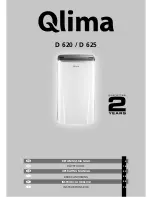
1
EGW05-SWHPEG-20140724
TM
TM
SECTION I: INDOOR POOL APPLICATION
INTRODUCTION
CREATING AN IDEAL ENVIRONMENT FOR INDOOR POOL FACILITIES
Indoor pool facilities are unlike any other structure in design, construction and maintenance requirements. Humidity, air
and water temperatures are especially difficult to control, and improper management usually results in an uncomfortable
environment, excessive operating costs and possibly serious structural damage. Effectively controlling these special
conditions require control hardware and control sequences specially engineered for large commercial indoor pool
applications. The PoolPak™ System utilizes an environmental control package designed to meet all special needs of the
indoor pool environment, while reducing energy usage and building maintenance costs.
OPERATING COST
Energy consumption is a direct function of the variables necessary to satisfy the occupant and protect the facility.
These variables include space heating and cooling, water heating, humidity removal and ventilation. Maintaining ideal
and precise environmental conditions has a fairly high cost of operation. A majority of the indoor pools, regardless of
geographic location, require water and space heating 70% to 90% of the year.
APPLICATION
MOISTURE LOADS
An indoor swimming pool produces large quantities of water vapor through evaporation, which accounts for roughly
95% of the pool water heat loss, making the water colder. This excessive humidity will form damaging condensation
unless removed from the building. In the past, the method of removing this water vapor was by ventilating an otherwise
energy efficient building, exhausting the humid air and the energy it contained. Additional energy was used to bring in
and heat the make-up air and to heat the pool water.
More cost effective technologies offer an alternative method adding heat exchangers and mechanical heat recovery
systems with many useful options. The ideal solution to removing the water vapor from the pool area is to convert the
latent (wet) heat contained in the moist air back into sensible (dry) heat, placing it back into the pool water and air.
EFFECTS OF MOISTURE
Excess humidity in natatorium structures may be readily apparent as condensation on cool surfaces such as windows and
outside doors, the growth of mildew or mold and when coupled with poor pool chemistry, the accelerated corrosion of
metals. In its less obvious forms, moisture may penetrate walls and ceilings and cause rot that becomes noticeable only
when large scale structural failure occurs. Humidity levels are also a major factor in the comfort of pool users.
INDOOR AIR QUALITY
Pools and water parks with water features have a higher evaporation rate than a standard pool because of the increased
water surface area. Chloramines (See Pool Water Chemistry below), which are present in the water, become more
concentrated in the air as the “water to air” interactions increase, affecting the indoor air quality. To control the buildup
of chloramines and gases in an enclosed poolroom, the space must have an adequate supply of outside air or ventilation
circulating through the structure at all times.








































